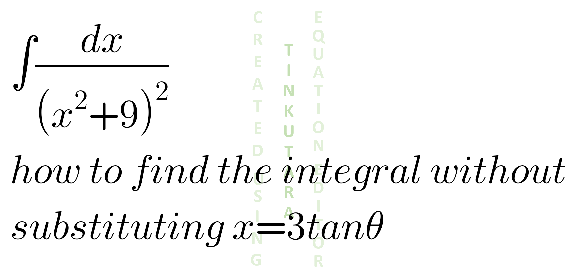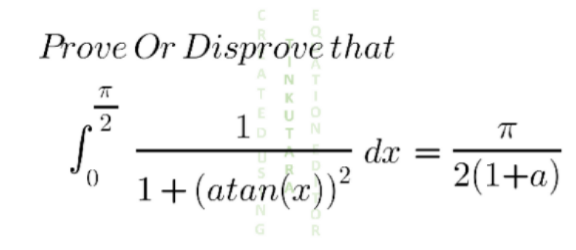
Question and Answers Forum
IntegrationQuestion and Answers: Page 92





|
Question and Answers Forum |
IntegrationQuestion and Answers: Page 92 |
| ∫(√(x/(x−1))) dx |
| ∫(√(x^2 +1 )) dx = ? |
| .....nice calculus... for f(x)=f(x+π) : ∫_(−∞) ^( ∞) f(x).((sin^2 (x))/x^2 )dx=^(why???) ∫_0 ^( π) f(x)dx |
| ......advanced calculus(I).... if : Ω=∫_(π/4) ^( (π/2)) ((x.cos(2x).cos(x))/(sin^7 (x))) dx=((aπ)/(90)) then :: a=??? |

|
| .....Advanced ◂.............▶ Calculus..... 𝛗=∫_(−∞) ^( ∞) ((sin((1/x^3 )))/x)dx=......??? solution:: 𝛗=^((1/x) =t) 2∫_0 ^( ∞) ((sin(t^3 ))/(1/t)).(dt/t^2 ) ............. =2∫_0 ^( ∞) ((sin(t^3 ))/t)dt ......... =^(t^3 =y) (2/3)∫_0 ^( ∞) ((sin(y))/y^(1/3) ).(dy/y^(2/3) )=(2/3)∫_0 ^( ∞) ((sin(y))/y) =^(⟨∫_0 ^( ∞) ((sin(r))/r)dr =(π/2)⟩) (π/3) ........... ........𝛗=∫_(−∞) ^( ∞) ((sin((1/x))^3 )/x)dx=(π/3) ........✓✓✓ |
| let C(a,r)={z∈C, ∣z−a∣=r } Let u,v,w ∈C(a,r) such as u+v=2w Prove that ((u−a)/(v−a)) =1 , u=v=w It shows that the middle of a segment joining two points in a circle is not in that circle |
| .....advanced calculus..... prove that :: ... 𝛗=∫_0 ^( ∞) ((1−e^(−x^2 ) )/x^2 )dx=(√π) |
| ....calculus (I)..... prove that :: f(x)= (1/( (√(1−4x)))) =^(???) Σ_(n=0) ^∞ ((( 2n)),(( n)) ) x^n |

|

|
| 𝛗=∫_0 ^( 1) ((ln(x^2 +1))/x^2 )dx f(a)=∫_0 ^( 1) ((log(ax^2 +1))/x^2 )dx f ′(a)=∫_0 ^( 1) (x^2 /((ax^2 +1)x^2 ))dx=(1/a)∫_0 ^( 1) (dx/(x^2 +((1/( (√a))))^2 )) =((√a)/a)[tan^(−1) (x(√a) )]_0 ^1 =((√a)/a)tan^(−1) ((√a)) f(a)=^((√a) =u) ∫2tan^(−1) (u)du =2{u.tan^(−1) (u)−∫(u/(1+u^2 ))du}+C =2(√a) tan^(−1) ((√a) )−ln(1+a)+C f(0)=0=0+C⇒C=0 f(1)=𝛗=2((π/4))−ln(2)=(π/2)−ln(2) |
| ..........nice calculus......... suppose that::: ϕ(p)=∫_0 ^( ∞) ((ln(1+x))/((p+x)^2 )) ...✓ find the value of:: ∫^( 1) _0 ((ϕ(p))/(1+p))dp=?... |
| ....advanced calculus.... 𝛗=∫_0 ^( (π/2)) x.(tan(x))^(1/2) dx=?? |
| ......nice calculus..... prove:: ∫_0 ^( 1) (1/(1+ln^2 (x)))dx=∫_(0 ) ^( ∞) ((sin(x))/(1+x))dx |
| f(x)=∫_(−Π/4) ^(Π∫/4) e^(xtant) dt |
| ∫_0 ^((50π)/3) ∣sinx∣dx |
| (a) Let I(α)=∫_0 ^∞ e^(−(x−(α/x))^2 ) dx Show that it is legitimate to take the derivative of I(α) and also I′(α)= 0. Then show that I(α)=((√π)/2). (b) Use (a) to prove ∫_0 ^∞ e^(−(x^2 +α^2 x^(−2) )) dx=((√π)/2)e^(−2α) . |

|

|
| ∫ (dx/(sin^6 x)) ? |
| If α>0 and β>0, prove ∫_0 ^∞ ((ln(αx))/(β^2 +x^2 ))dx=(π/(2β))ln(αβ) |
| calculate A_λ =∫_0 ^∞ ((cos^4 x)/((x^2 +λ^2 )^2 ))dx 2) find the value of ∫_0 ^∞ ((cos^4 x)/((x^2 +3)^2 ))dx |
| if f(x)=x^3 −3x+2 determine f^(−1) (x) and ∫ f^(−1) (nf(x))dx with n integr |
| find ∫ ((arctan(2x))/(x+3))dx |
| find U_n =∫_(1/n) ^n (1−(1/x^2 ))arctan(x+(1/x))dx and lim_(n→∞) U_n |